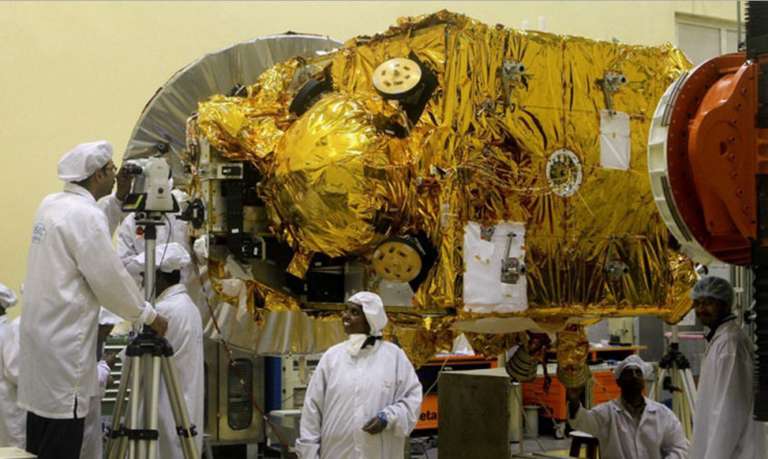Emily Lakdawalla • Sep 23, 2013
Photos and Video of India's Mars Orbiter Mission, proceeding toward October 28 launch
Indian media reported over the weekend that the Mars Orbiter Mission has passed some senior review, and has been approved to proceed toward a launch date of October 28, with the launch taking place in the afternoon. This is one week later than previously planned; I haven't found any reason cited for the delay. The launch period closes November 19. The same article states that the spacecraft is now undergoing vibration testing and that there will be a pre-shipment review on Thursday. Assuming the spacecraft passes that review, it is expected to be shipped to the launch site at Sriharikota a week from today, on September 30. The launch vehicle is being assembled, and the spacecraft will be stacked onto the rocket on October 10.
The Indian Space Research Organisation (ISRO) held a media day for viewing of their Mars Orbiter Mission two weeks ago, so lots of photos of actual hardware have been trickling out onto the Web since then. I've assembled a bunch of them into an album on Flickr. Here are some highlights:

Check the Flickr photo album for more. And here are a couple of news reports containing video evidently shot at the same time as those photos. The videos were originally posted to nasaspaceflight.com by Shashi Raj Singh.
The news from the Curiosity mission last week that the rover has performed six atmospheric analyses without detecting a whiff of methane has produced a little bit of consternation in India. (For excellent writeups of the Curiosity results, try Jonathan Amos at BBC or Robert Gonzalez at io9.) One of the Mars Orbiter Mission's five scientific instruments is a dedicated methane sensor. It seems this sensor may be fated to produce a null result before the spacecraft has even launched.
NASA's MAVEN mission will be looking for methane as well, but MAVEN's science team has always downplayed the significance of methane detection, making it clear that their mission is intended to characterize many trace gases at Mars. Here's one planning document that states "It’s not just about methane!" and goes on to say "A Trace Gas Mission must provide...a definitive statement about whether or not methane is still present in the atmosphere and characterize whatever variability it has. However, a detailed inventory of atmospheric gases and their isotopologues will be a major advance in our understanding of the recent history and climate of Mars whether or not methane is detected."
Still, ISRO's leaders have played up the question of extant life on Mars as being one of the drivers for the Mars Orbiter Mission. So it's a little surprising to me to see the lack of planetary protection precautions being taken in the photos from the Mars Orbiter Mission's so-called "clean room" above. Bare hands, unmasked facial hair, uncovered clothing, and street shoes must be bringing plenty of organic material into that room, and leaving it on the spacecraft. Compare the attire of the ISRO workers to that of the people preparing MAVEN for launch on the same kind of mission to the same planet:

It's certainly worth asking whether the MAVEN level of planetary protection is really necessary on a spacecraft that should mostly burn up if it ever enters Mars' atmosphere, and it's worth pointing out that if we're serious about eventually sending humans to the surface of Mars, then planetary protection is impossible anyway. If it were to crash, the Mars Orbiter Mission would add no more load of Earthly contamination to Mars than any of the failed Russian missions did. But still. If you're going to talk about organics and methane I think it would behoove you to make sure you're bringing as little of both with you as possible.
Support our core enterprises
Your support powers our mission to explore worlds, find life, and defend Earth. You make all the difference when you make a gift. Give today!
Donate

 Explore Worlds
Explore Worlds Find Life
Find Life Defend Earth
Defend Earth




